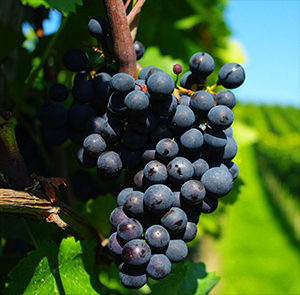In case you missed it, the 20th anniversary of the Merlot-bashing movie "Sideways" just passed. No one could have predicted that when Miles angrily yelled, "I am NOT drinking any f@%#&$g Merlot," that people would swear off Merlot and sales would fall off a cliff.
But when the dust settled, wine industry watchers noticed that did not exactly happen. Miles, a dedicated Pinot Noir fan, did let everyone in the room know of his dislike for Merlot, and new plantings and sales of Merlot dropped off, but not for long.
Following the release of the movie in 2004, plantings of Merlot decreased statewide, while Pinot Noir increased. Opinions differ on why, but a common complaint about California Merlot in 2004 was that a lot of it was too vegetative and green.
Today, there is four times as much Merlot in the state and the varietal's soft berry-rich flavors make it a popular seller at retail and on restaurant wine lists.
| Ah, let's see... |
The setting for one of the most successful wine movies ever was the Santa Ynez Valley, in Santa Barbara County, a premier spot for California Pinot Noir. Miles (Paul Giamatti) told his friend, Jack (Thomas Haden-Church), "We're gonna drink a lot of good wine. We're gonna play some golf. We're gonna eat some great food and enjoy the scenery and we're gonna send you off in style, mon frere."
As it turns out, the eager pair meet up with Maya (Virginia Madsen) and Stephanie (Sandra Oh). In the 20 years since, Giamatti has gone on to stardom in films and television, Oh has made her mark in television, while Haden-Church and Madsen seem to have disappeared.
That's show biz; you can be a star one day and out of work the next. But here's the crazy thing: Miles' angry snarl had a measurable impact on the sales of California Merlot. And, when he confessed his devotion for Pinot Noir, by indulging his passion with a pilgrimage to the Santa Ynez Valley, the Central Coast wine region took on new interest for wine day trippers as the place to visit.
Miles was demonstrating his self-proclaimed reputation as an authority on Santa Ynez Pinot Noir and food, and he and Jack, Maya and Stephanie visited some of the valley's popular watering spots, like the Fess Parker Winery, Andrew Murray and Firestone Vineyard for Pinot Noir, and Los Olivos Wine Merchant & Cafe and the Hitching Post 2, in Buellton.
The original Hitching Post is in Casmalia, in the shadow of Vandenberg Air Force Base and the West Coast launch pad for NASA heavy lift rockets. Hitching Post has long been known for barbecue steaks and grilled artichokes. Local legend claims that the grilled steaks glow in the dark because of the Hitching Post being near Vandenberg and its rocket activity.
One of the natural features that allows California wineries to grow so many different wine grapes, is a series of mesoclimates, a common term today that defines a vineyard or a potential site for a vineyard. A mesoclimate falls between a macroclimate and a microclimate.
There are seven sub regions in the Santa Ynez Valley, each with a different mesoclimate, supporting a diverse range of varieties. Pinot Noir and Chardonnay find the right conditions in the western Santa Rita Hills, that open directly to the cooling breezes of the Pacific Ocean. Syrah and other Rhone varieties grow better in the inland area of Ballard Canyon. Further east, in warmer sites like Happy Canyon, Bordeaux varieties thrive.
Miles was looking for Pinot Noir, a variety he believed is the Holy Grail of red wine. Jack tagged along, but to Miles' irritation was more interested in the pursuit of women than wine. Undaunted, Miles was looking to the Santa Rita Hills Pinot Noirs for seductive black cherry flavors, exotic spices and firm tannins, the ingredients, the combination he was sure he and Jack would find from Sea Smoke Cellars, Babcock Winery, Sanford Winery, Sanford & Benedict Vineyard and Lafond Winery.
Merlot and Pinot Noir; you'll find both in the Santa Ynez Valley. And, you just might spy Miles Raymond on his quest to find the Holy Grail.
Next post: Defining Steen and Pinotage
Email me at boydvino707@gmail.com






